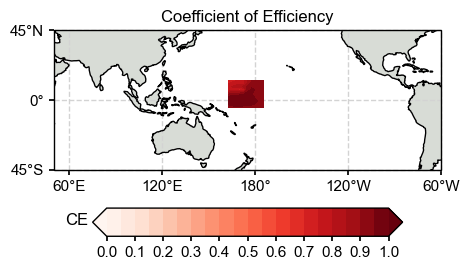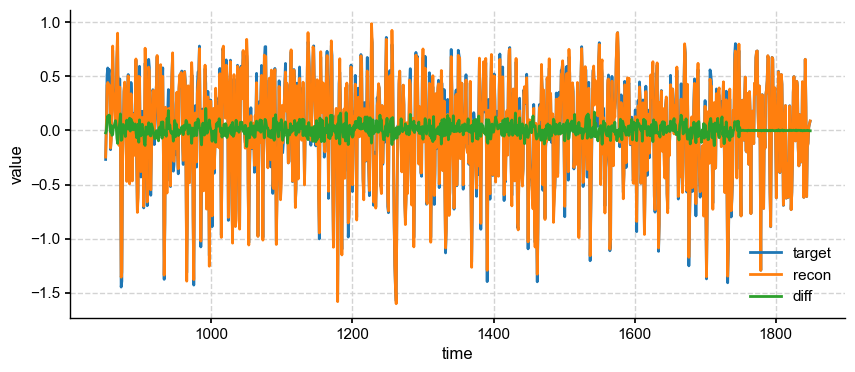A Pseudoproxy Experiment with GraphEM
Expected time to run through: 10 mins
This tutorial demonstrates how to get a reconstruction using GraphEM, leveraging a simple pseudoproxy dataset generated from a subset of iCESM gridded dataset. The pseudoproxy are generated based on the original iCESM simulated tas plus white noise with SNR=1, using below code block:
# gen pseudoproxy
SNR = 1
pp = np.copy(tas_sub)
nt, nlat, nlon = np.shape(pp)
k = 0
for i in range(nlat):
for j in range(nlon):
tas_std = np.std(tas_sub[:,i,j])
noise_std = tas_std / SNR
np.random.seed(k)
pp[:,i,j] += np.random.normal(0, noise_std, size=nt)
k += 1
Test data preparation
To go through this tutorial, please prepare test data following the steps:
Download the test case named “PPE” with this link. Create a directory named “testcases” in the same directory where this notebook sits. Put the unzipped direcotry “PPE” into “testcases”.
Below, we first load some useful packages, including our GraphEM.
[1]:
%load_ext autoreload
%autoreload 2
import LMRt
import GraphEM
import os
import numpy as np
import pandas as pd
import xarray as xr
import matplotlib.pyplot as plt
Reconstruction
[2]:
job = GraphEM.ReconJob()
[3]:
job.load_configs('./testcases/PPE/configs.yml', verbose=True)
GraphEM: job.load_configs() >>> loading reconstruction configurations from: ./testcases/PPE/configs.yml
GraphEM: job.load_configs() >>> job.configs created
GraphEM: job.load_configs() >>> job.configs["job_dirpath"] = /Users/fzhu/Github/GraphEM/docsrc/tutorial/testcases/PPE/recon
GraphEM: job.load_configs() >>> /Users/fzhu/Github/GraphEM/docsrc/tutorial/testcases/PPE/recon created
{'anom_period': [1951, 1980],
'calib_period': [1750, 1849],
'job_dirpath': '/Users/fzhu/Github/GraphEM/docsrc/tutorial/testcases/PPE/recon',
'job_id': 'LMRt_quickstart',
'obs_path': {'tas': './data/obs/iCESM_subset.nc'},
'obs_varname': {'lat': 'lat', 'lon': 'lon', 'tas': 'tas'},
'proxydb_path': './data/proxy/pseudoproxy_dataset.pkl',
'ptype_list': ['coral.d18O'],
'recon_period': [850, 1849]}
[4]:
job.load_proxydb(verbose=True)
GraphEM: job.load_proxydb() >>> job.configs["proxydb_path"] = /Users/fzhu/Github/GraphEM/docsrc/tutorial/testcases/PPE/data/proxy/pseudoproxy_dataset.pkl
GraphEM: job.load_proxydb() >>> 100 records loaded
GraphEM: job.load_proxydb() >>> job.proxydb created
[5]:
job.filter_proxydb(verbose=True)
GraphEM: job.filter_proxydb() >>> filtering proxy records according to: ['coral.d18O']
GraphEM: job.filter_proxydb() >>> 100 records remaining
[6]:
job.load_obs(verbose=True)
GraphEM: job.load_obs() >>> loading instrumental observation fields from: {'tas': '/Users/fzhu/Github/GraphEM/docsrc/tutorial/testcases/PPE/data/obs/iCESM_subset.nc'}
Time axis not overlap with the reference period [1951, 1980]; use its own time period as reference [850.00, 1849.00].
GraphEM: job.load_obs() >>> job.obs created
[7]:
print(job.obs)
Dataset Overview
-----------------------
Name: tas
Source: /Users/fzhu/Github/GraphEM/docsrc/tutorial/testcases/PPE/data/obs/iCESM_subset.nc
Shape: time:1000, lat:10, lon:10
Since the loaded iCESM simulation and the pseudoproxy dataset are already annualized, we can skip the .seasonalize() steps and run .prep_data() directly.
[8]:
job.prep_data(verbose=True)
GraphEM: job.prep_data() >>> job.recon_time created
GraphEM: job.prep_data() >>> job.calib_time created
GraphEM: job.prep_data() >>> job.calib_idx created
GraphEM: job.prep_data() >>> job.temp created
GraphEM: job.prep_data() >>> job.df_proxy created
GraphEM: job.prep_data() >>> job.proxy created
GraphEM: job.prep_data() >>> job.lonlat created
[9]:
job.df_proxy
[9]:
| pp_000 | pp_001 | pp_002 | pp_003 | pp_004 | pp_005 | pp_006 | pp_007 | pp_008 | pp_009 | ... | pp_090 | pp_091 | pp_092 | pp_093 | pp_094 | pp_095 | pp_096 | pp_097 | pp_098 | pp_099 | |
|---|---|---|---|---|---|---|---|---|---|---|---|---|---|---|---|---|---|---|---|---|---|
| 850.0 | 300.751783 | 300.699385 | 299.718651 | 300.717691 | 299.793416 | 299.939352 | 299.472350 | 300.551011 | 299.553801 | 299.413664 | ... | 299.249156 | 299.027787 | 299.182322 | 299.526141 | 299.161496 | 298.628304 | 298.802706 | 298.107757 | 298.818966 | 298.544758 |
| 851.0 | 300.496749 | 300.009875 | 300.193606 | 300.365040 | 300.347096 | 299.853183 | 300.380611 | 299.650771 | 300.502845 | 299.614965 | ... | 299.103565 | 298.778987 | 299.141563 | 299.335989 | 299.410467 | 298.670001 | 298.838717 | 298.689713 | 299.370283 | 299.494514 |
| 852.0 | 300.902166 | 300.334244 | 299.602851 | 300.671260 | 300.102458 | 301.886292 | 300.641600 | 300.462630 | 299.210613 | 299.595454 | ... | 299.289380 | 299.249218 | 299.134434 | 299.942948 | 298.988984 | 299.277950 | 298.905532 | 298.840735 | 299.414093 | 299.140887 |
| 853.0 | 301.729269 | 300.347924 | 301.572955 | 299.850196 | 301.104819 | 300.567805 | 300.145062 | 300.817268 | 299.709402 | 300.448917 | ... | 299.573146 | 299.649931 | 298.838391 | 299.710779 | 300.040319 | 299.609617 | 299.473822 | 299.656169 | 299.019936 | 299.719184 |
| 854.0 | 301.378359 | 300.997108 | 299.769165 | 300.429641 | 300.280460 | 300.495473 | 298.998074 | 299.858000 | 298.895901 | 299.967372 | ... | 300.078972 | 300.040279 | 299.551374 | 300.088576 | 298.790187 | 299.790875 | 299.441056 | 299.184892 | 299.035147 | 299.345002 |
| ... | ... | ... | ... | ... | ... | ... | ... | ... | ... | ... | ... | ... | ... | ... | ... | ... | ... | ... | ... | ... | ... |
| 1845.0 | 300.370235 | 300.113197 | 300.144971 | 299.726555 | 299.921271 | 300.382517 | 299.913085 | 299.789860 | 299.300107 | 299.261318 | ... | 299.482236 | 299.063248 | 299.152310 | 298.784250 | 298.994037 | 298.300974 | 299.091353 | 298.409069 | 298.584221 | 298.305443 |
| 1846.0 | 299.985712 | 298.994364 | 300.207191 | 299.883894 | 300.684450 | 300.181971 | 300.745885 | 299.919197 | 298.775608 | 299.324020 | ... | 299.544706 | 299.056843 | 299.350263 | 299.165946 | 299.459059 | 299.227588 | 299.156746 | 299.367724 | 299.111197 | 298.400678 |
| 1847.0 | 300.292753 | 300.177510 | 300.033955 | 300.236235 | 299.559872 | 299.877648 | 299.141349 | 299.497879 | 299.952182 | 299.577197 | ... | 299.724081 | 300.424495 | 299.179294 | 299.375003 | 299.475237 | 299.947260 | 300.159204 | 299.223168 | 299.384652 | 299.483399 |
| 1848.0 | 299.823016 | 300.400975 | 300.223044 | 300.913630 | 300.261049 | 300.159285 | 299.311807 | 299.449942 | 299.660750 | 298.979497 | ... | 299.829125 | 299.592597 | 300.013318 | 299.155958 | 299.107011 | 299.086289 | 299.878042 | 299.307766 | 299.593688 | 298.706442 |
| 1849.0 | 300.161352 | 300.159181 | 300.246488 | 299.820504 | 299.517483 | 299.951131 | 299.332212 | 299.316922 | 299.630661 | 299.881939 | ... | 299.587589 | 298.878817 | 298.997188 | 298.895755 | 299.134630 | 299.284257 | 299.369434 | 299.400078 | 299.026855 | 299.096824 |
1000 rows × 100 columns
[10]:
print(np.shape(job.temp))
print(np.shape(job.proxy))
print(np.shape(job.lonlat))
(1000, 100)
(1000, 100)
(200, 2)
[11]:
job.save(verbose=True)
LMRt: job.save_job() >>> Prepration data saved to: /Users/fzhu/Github/GraphEM/docsrc/tutorial/testcases/PPE/recon/job.pkl
LMRt: job.save_job() >>> job.configs["prep_savepath"] = /Users/fzhu/Github/GraphEM/docsrc/tutorial/testcases/PPE/recon/job.pkl
[12]:
%%time
save_path = './testcases/PPE/recon/G.pkl'
job.run_solver(save_path=save_path, verbose=True)
Estimating graph using neighborhood method
Running GraphEM:
Iter dXmis rdXmis
001 0.0514 3.1516
002 0.4586 8.5151
003 0.0562 0.1136
004 0.0292 0.0566
005 0.0149 0.0287
006 0.0123 0.0235
007 0.0107 0.0203
008 0.0092 0.0174
009 0.0081 0.0152
010 0.0073 0.0137
011 0.0067 0.0126
012 0.0063 0.0117
013 0.0059 0.0110
014 0.0055 0.0103
015 0.0053 0.0098
016 0.0050 0.0094
017 0.0048 0.0090
018 0.0047 0.0087
019 0.0045 0.0084
020 0.0044 0.0082
021 0.0043 0.0079
022 0.0041 0.0077
023 0.0040 0.0075
024 0.0039 0.0072
025 0.0038 0.0070
026 0.0036 0.0068
027 0.0035 0.0065
028 0.0034 0.0063
029 0.0033 0.0061
030 0.0032 0.0059
031 0.0031 0.0057
032 0.0030 0.0055
033 0.0029 0.0053
034 0.0028 0.0051
035 0.0027 0.0050
GraphEM: job.run_solver() >>> job.G created and saved to: ./testcases/PPE/recon/G.pkl
GraphEM: job.run_solver() >>> job.recon created
CPU times: user 18.2 s, sys: 3.42 s, total: 21.6 s
Wall time: 3.45 s
[13]:
job.save_recon('./testcases/PPE/recon/recon.nc', verbose=True)
LMRt: job.save_recon() >>> Reconstruction saved to: ./testcases/PPE/recon/recon.nc
Validation
[14]:
with xr.open_dataset('./testcases/PPE/recon/recon.nc') as ds:
print(ds)
<xarray.Dataset>
Dimensions: (lat: 10, lon: 10, year: 1000)
Coordinates:
* year (year) int64 850 851 852 853 854 855 ... 1845 1846 1847 1848 1849
* lat (lat) float32 -4.737 -2.842 -0.9474 0.9474 ... 8.526 10.42 12.32
* lon (lon) float32 162.5 165.0 167.5 170.0 ... 177.5 180.0 182.5 185.0
Data variables:
recon (year, lat, lon) float64 ...
[15]:
target = job.obs.fields['tas'].value
Mean Statistics
[76]:
nt = np.size(ds['year'])
temp_r = job.recon.reshape((nt, -1))
V = GraphEM.solver.verif_stats(temp_r,target.reshape((nt, -1)), job.calib_idx)
print(V)
Mean MSE = 0.0206, Mean RE = 0.9000, Mean CE = 0.8999, Mean R2 = 0.9022
Map of CE
[16]:
ce = LMRt.utils.coefficient_efficiency(target, ds['recon'])
print(np.shape(ce))
(10, 10)
[73]:
import seaborn as sns
import cartopy.crs as ccrs
import cartopy.feature as cfeature
from cartopy.mpl.ticker import LongitudeFormatter, LatitudeFormatter
fig = plt.figure(figsize=[5, 5])
ax = plt.subplot(projection=ccrs.PlateCarree(central_longitude=180))
ax.set_title('Coefficient of Efficiency')
latlon_range = [50, 300, -45, 45]
transform=ccrs.PlateCarree()
ax.set_extent(latlon_range, crs=transform)
lon_formatter = LongitudeFormatter(zero_direction_label=False)
lat_formatter = LatitudeFormatter()
ax.xaxis.set_major_formatter(lon_formatter)
ax.yaxis.set_major_formatter(lat_formatter)
lon_ticks=[60, 120, 180, 240, 300]
lat_ticks=[-90, -45, 0, 45, 90]
lon_ticks = np.array(lon_ticks)
lat_ticks = np.array(lat_ticks)
lon_min, lon_max, lat_min, lat_max = latlon_range
mask_lon = (lon_ticks >= lon_min) & (lon_ticks <= lon_max)
mask_lat = (lat_ticks >= lat_min) & (lat_ticks <= lat_max)
ax.set_xticks(lon_ticks[mask_lon], crs=ccrs.PlateCarree())
ax.set_yticks(lat_ticks[mask_lat], crs=ccrs.PlateCarree())
levels = np.linspace(0, 1, 21)
cbar_labels = np.linspace(0, 1, 11)
cbar_title = 'CE'
extend = 'both'
cmap = 'Reds'
cbar_pad=0.1
cbar_orientation='horizontal'
cbar_aspect=10
cbar_fraction=0.35
cbar_shrink=0.8
font_scale=1.5
land_color=sns.xkcd_rgb['light grey']
ocean_color=sns.xkcd_rgb['white']
ax.add_feature(cfeature.LAND, facecolor=land_color, edgecolor=land_color)
ax.add_feature(cfeature.OCEAN, facecolor=ocean_color, edgecolor=ocean_color)
ax.coastlines()
im = ax.contourf(ds['lon'].values, ds['lat'].values, ce, levels, transform=transform, cmap=cmap, extend=extend)
cbar = fig.colorbar(
im, ax=ax, orientation=cbar_orientation, pad=cbar_pad, aspect=cbar_aspect,
fraction=cbar_fraction, shrink=cbar_shrink)
cbar.set_ticks(cbar_labels)
cbar.ax.set_title(cbar_title, x=-0.05, y=0.1)
LMRt.showfig(fig)

Mean timeseries
[79]:
import pyleoclim as pyleo
[81]:
def geo_mean(field, lat):
m = np.average(
np.average(field, axis=-1), axis=-1, weights=np.cos(np.deg2rad(lat))
)
return m
[87]:
m_target = geo_mean(job.obs.fields['tas'].value, job.obs.fields['tas'].lat)
ts_target = pyleo.Series(time=job.obs.fields['tas'].time, value=m_target)
m_recon = geo_mean(ds['recon'].values, ds['lat'].values)
ts_recon = pyleo.Series(time=ds['year'].values, value=m_recon)
fig, ax = ts_target.plot(mute=True, label='target')
ts_recon.plot(ax=ax, label='recon')
ax.plot(ds['year'].values, m_target-m_recon, label='diff')
ax.legend()
pyleo.showfig(fig)

[ ]: